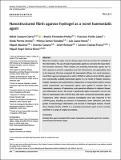Por favor, use este identificador para citar o enlazar a este item:
http://hdl.handle.net/10261/201521COMPARTIR / EXPORTAR:
 SHARE SHARE
 CORE
BASE CORE
BASE
|
|
| Visualizar otros formatos: MARC | Dublin Core | RDF | ORE | MODS | METS | DIDL | DATACITE | |

| Título: | Nanostructured fibrin agarose hydrogel as a novel haemostatic agent |
Autor: | Campos-Cuerva, Rafael; Fernández-Muñoz, Beatriz CSIC ORCID CVN; Farfán López, Francisco; Pereira, Sheila CSIC ORCID; Santos-González, Mónica; López-Navas, Luis; Alaminos Mingorance, Miguel; Campos, Antonio; Muntané, Jordi CSIC ORCID; Cepeda-Franco, Carmen CSIC ORCID; Gómez-Bravo, Miguel A. CSIC ORCID | Palabras clave: | Bleeding Fibrin agarose hydrogel Fibrin sealant Haemostasis Haemostatic agent Liver resection Nanostructured biomaterials Surgery |
Fecha de publicación: | abr-2019 | Editor: | Wiley-Blackwell | Citación: | Journal of Tissue Engineering and Regenerative Medicine 13(4): 664-673 (2019) | Resumen: | Blood loss remains a major concern during surgery and can increase the morbidity of the intervention. The use of topical haemostatic agents to overcome this issue therefore becomes necessary. Fibrin sealants are promising haemostatic agents due to their capacity to promote coagulation, but their effectiveness and applicability need to be improved. We have compared the haemostatic efficacy of a novel nanostructured fibrin‐agarose hydrogel patch, with (c‐NFAH) or without cells (a‐NFAH), against two commercially available haemostatic agents in a rat model of hepatic resection. Hepatic resections were performed by making short or long incisions (mild or severe model, respectively), and haemostatic agents were applied to evaluate time to haemostasis, presence of haematoma, post‐operative adhesions to adjacent tissues, and inflammation factors. We found a significantly higher haemostatic success rate (time to haemostasis) with a‐NFAH than with other commercial haemostatic agents. Furthermore, other relevant outcomes investigated were also improved in the a‐NFAH group, including no presence of haematoma, lower adhesions, and lower grades of haemorrhage, inflammation, and necrosis in histological analysis. Overall, these findings identify a‐NFAH as a promising haemostatic agent in liver resection and likely in a range of surgical procedures. | Versión del editor: | https://doi.org/10.1002/term.2831 | URI: | http://hdl.handle.net/10261/201521 | DOI: | 10.1002/term.2831 | ISSN: | 1932-6254 | E-ISSN: | 1932-7005 |
| Aparece en las colecciones: | (IBIS) Artículos |
Ficheros en este ítem:
| Fichero | Descripción | Tamaño | Formato | |
|---|---|---|---|---|
| Campos-Cuerva_et_al-2019.pdf | 907,04 kB | Adobe PDF |  Visualizar/Abrir |
CORE Recommender
PubMed Central
Citations
4
checked on 23-mar-2024
SCOPUSTM
Citations
9
checked on 20-abr-2024
WEB OF SCIENCETM
Citations
10
checked on 24-feb-2024
Page view(s)
253
checked on 24-abr-2024
Download(s)
151
checked on 24-abr-2024

